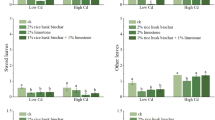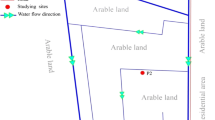Abstract
Cadmium (Cd) is among the most widespread and toxic heavy metals becoming a severe threat to humans. A field study was conducted to examine the role of various zinc (Zn) fertilization treatments and cultivars on crop productivity and Zn and Cd concentrations in brown rice and rice straw. The Zn fertilization treatments included an unfertilized control, foliar applied Zn sulfate (ZnSO4) at panicle initiation stage, foliar applied ZnSO4 at milky stage, soil application of rubber ash, and soil-applied ZnSO4, while five rice cultivars were Swat-1, Shadab, Shua-92, Swat-2, and Sada Hayat. All the Zn fertilization treatments resulted in significantly higher number of panicles, number of spikelets per panicles, spikelet fertility, 1,000-grain weight, grain yield, brown rice and rice straw Zn concentrations, and significantly lower Cd concentrations. Soil application of rubber ash remained the best among all Zn fertilization treatments as it resulted in 73 % higher grain yield and reduced Cd concentration by 51 % as compared with control. Variations were also apparent among cultivars, and Shua-92 and Swat-2 performed better in terms of all studied attributes as compared with other cultivars. Conclusively, cultivar selection and Zn application are effective strategies to improve rice grain yield as well as quality. Rubber ash appeared a viable source of Zn having the ability to increase yield along with reducing Cd accumulation.




Similar content being viewed by others
References
Afyuni M, Khoshgoftarmanesh AH, Dorostkar V, Moshiri R (2007) Zinc and cadmium content in fertilizer commonly used in Iran. In: International Conference of Zinc Crops, Istanbul, Turkey
Akay A, Koleli N (2007) Interaction between cadmium and zinc in barley (Hordeum vulgare L.) grown under field conditions. Bangladesh J Bot 36:13–19
Arao T, Ae N (2003) Genotypic variations in cadmium levels of rice grain. Soil Sci Plant Nutr 49:473–479
Arao T, Ishikawa S (2006) Genotypic differences in cadmium concentration and distribution of soybeans and rice. Jpn Agric Res Q 40:21–30
Basta NT, Tabatabai MA (1992) Effect of cropping systems on adsorption of metals by soils. III. Competitive adsorption. Soil Sci 153:331–337
Bhatti HM, Rashid M (1985) Micronutrient research in Pakistan. Proc. Rice Prod. Seminar, Larkana. pp 67–72
Brar MS, Sekhon GS (1976) Effect of Fe and Zn on the availability of micronutrients under flooded and unflooded condition. J Indian Soc Soil Sci 24:446–454
Cakmak I, Pfeiffer WH, McClafferty B (2010) Review: biofortification of durum wheat with zinc and iron. Cereal Chem 87:10–20
Chaney RL (2007) Effect of ground rubber vs. ZnSO4 on spinach accumulation of Cd from Cd-mineralized California soil. Abstract, WEFTECH Residuals Conference, Denver, CO, April, 2007
Chaudhary SK, Thakur SK, Pandey AK (2007) Response of wetland rice to nitrogen and zinc. Oryza 44:31–34
Choudhary M, Bailey LD, Grant CA (1994) Effect of zinc on cadmium concentration in the tissue of durum wheat. Can J Plant Sci 74:549–552
Clemins S, Palmgren MG, Krämer U (2002) A long way ahead: understanding and engineering plant metal accumulation. Trends Plant Sci 7:309–315
Fageria NK, Slaton NA, Baligar VC (2003) Nutrient management for improving lowland rice productivity and sustainability. Adv Agron 80:63–152
Fageria NK, Dos Santos AB, Cobucci T (2011) Zinc nutrition of lowland rice. Commun Soil Sci Plant Anal 42:1719–1727
Fahad S, Bano A (2012) Effect of salicylic acid on physiological and biochemical characterization of maize grown in saline area. Pak J Bot 44:1433–1438
Fahad S, Hussain S, Bano A, Saud S, Hassan S, Shan D, Khan FA, Khan F, Chen Y, Wu C, Tabassum MA, Chun MX, Afzal M, Jan A, Jan MT, Huang J (2014a) Potential role of phytohormones and plant growth-promoting rhizobacteria in abiotic stresses: consequences for changing environment. Environ Sci Pollut Res. doi:10.1007/s11356-014-3754-2
Fahad S, Hussain S, Matloob A, Khan FA, Khaliq A, Saud S, Hassan S, Shan D, Khan F, Ullah N, Faiq M, Khan MR, Tareen AK, Khan A, Ullah A, Ullah N, Huang J (2014b) Phytohormones and plant responses to salinity stress: a review. Plant Growth Regul. doi:10.1007/s10725-014-0013-y
Fahad S, Nie L, Chen Y, Wu C, Xiong D, Saud S, Hongyan L, Cui K, Huang J (2015a) Crop plant hormones and environmental stress. Sustain Agric Rev 15:371–400
Fahad S, Hussain S, Saud S, Hassan S, Darakhshan, Chen Y et al (2015b) Grain cadmium and zinc concentrations in maize influenced by genotypic variations and zinc fertilization. Clean Soil Air Water. doi:10.1002/clen.201400376
Furlani AMC, Furlani PR, Meda AR, Durate AP (2005) Efficiency of maize cultivars for zinc uptake and use. Sci Agric 62:264–273
Gee GW, Bauder JW (1982) Particle size analysis. In: Klute A (ed) Methods of soil analysis, part 1: physical and mineralogical methods, 2nd edn. American Society of Agronomy, Madison, pp 383–411
Gomes DS, Fragoso LC, Riger CJ, Panek AD, Eleutherio ECA (2002) Regulation of cadmium uptake by Saccharomyces cerevisiae. Biochim Biophys Acta 1573:21–25
Grant CA, Clarke JM, Duguid S, Chaney RL (2008) Selection and breeding of plant cultivars to minimize cadmium accumulation. Sci Total Environ 390:301–310
Hart JJ, Welch RM, Norvell WA, Kochian LV (2002) Transport interactions between cadmium and zinc in roots of bread and durum wheat seedlings. Physiol Plant 116:73–78
Hassan MJ, Zhang G, Wu F, Wei K, Chonghua C (2005) Zinc alleviates growth inhibition and oxidative stress caused by cadmium toxicity in rice. J Plant Nutr Soil Sci 168:256–261
He JY, Zhu C, Ren YF, Yan YP, Jiang D (2006) Genotypic variation in grain cadmium concentration of lowland rice. J Plant Nutr Soil Sci 169:711–716
IRRI (2000) Nutritional disorders and nutrient management in rice. Inter Rice Res Ins, Manila
Kanwal S, Rahmatullah, Ranjha AM, Ahmad R (2010) Zinc partitioning in maize grain after soil fertilization with zinc sulfate. Int J Agric Biol 12:299–302
Kausar MA, Ali S, Iqbal MI (2001) Zinc nutrition of three rice varieties in alkaline calcareous soils. Pak J Soil Sci 20:9–14
Khoshgoftarmanesh AH, Schulin R, Chaney RL, Daneshbakhsh B, Afyuni M (2010) Micronutrient-efficient genotypes for crop yield and nutritional quality in sustainable agriculture. A review. Agron Sustain Dev 30:83–107
Kim J, Shon J, Lee CK, Yang W, Yoon W, Yang WH, Kim YG, Lee BW (2011) Relationship between grain filling duration and leaf senescence of temperate rice under high temperature. Field Crop Res 122:207–213
Lindsay WL, Norvell WA (1978) Development of a DTPA soil test for zinc, iron, manganese and copper. Soil Sci Soc Am J 42:421–428
Liu J, Qian M, Cai G, Yang J, Zhu Q (2007) Uptake and translocation of Cd in different rice cultivars and the relation with Cd accumulation in rice grain. J Hazard Mater 143:443–447
Liu H, Hussain S, Peng S, Huang J, Cui K, Nie L (2014a) Potentially toxic elements concentration in milled rice differ among various planting patterns. Field Crops Res 168:19–26
Liu H, Hussain S, Zheng M, Sun L, Fahad S, Huang J, Cui K, Nie L (2014b) Progress and constraints of dry direct-seeded rice in China. J Food Agric Environ 12:465–472
Liu H, Hussain S, Zheng M, Peng S, Huang J, Cui K, Nie L (2015) Dry direct-seeded rice as an alternative to transplanted-flooded rice in Central China. Agron Sust Dev 35:285–294
Maclean JC, Dawe DC, Hardy B, Hettel GP (2002) Rice almanac, 3rd edn. CABI Publishing, Wallingford, p 253
McLean EO (1982) Soil pH and lime requirement. In: Page AL (ed) Methods of soil analysis, part 2: chemical and microbiological properties. American Society of Agronomy, Madison, pp 199–224
Miller JF, Green CE, Li YM, Chaney RL (2006) Registration of three low cadmium (HA 448, HA 449, and RHA 450) confection sunflower genetic stocks. Crop Sci 46:489–490
Mollah MZI, Talukder NM, Islam MN, Ferdous Z (2009) Effect of nutrients content in rice as influenced by zinc fertilization. World Appl Sci J 6(8):1082–2009
Naik SK, Das DK (2007) Effect of split application of zinc on yield of rice (Oryza sativa L.) in an Inceptisol. Arch Agron Soil Sci 53(3):305–313
Nand R, Ram N (1996) Amelioration of zinc stress by farmyard manure in a rice-wheat-cowpea system. Acta Agron Hung 44(1):35–39
Nelson DW, Sommers LE (1982) Carbon, organic carbon and organic matter. In: Page AL (ed) Methods of soil analysis, part 2: chemical and microbiological properties. American Society of Agronomy, Madison, pp 539–580
Rahman MT, Jahiruddin M, Humauan MR, Alam MJ, Khan AA (2008) Effect of sulphur and zinc on growth, yield and nutrient uptake of boro rice (cv. Brri Dhan 29). J Soil Nat 2:10–15
Saleh MI, Meullenet JF, Siebenmorgen TJ (2008) Development and validation of prediction models for rice surface lipid content and color parameters using near-infrared spectroscopy: a basis for predicting rice degree of milling. Cereal Chem 85:787–791
Saud S, Chen Y, Baowen L, Fahad S, Arooj S (2013) The different impact on the growth of cool season turf grass under the various conditions on salinity and drought stress. Int J Agric Sci Res 3(4):77–84
Saud S, Li X, Chen Y, Zhang L, Fahad S, Hussain S, Sadiq A, Chen Y (2014) Silicon application increases drought tolerance of Kentucky bluegrass by improving plant water relations and morphophysiological functions. Sci World J. doi:10.1155/2014/368694
Selvi S, Ramaswami PP (1995) Residual effect of integrated nutrient management in rice-rice-pulse cropping sequence. Madras Agric J 82:24–26
Slaton NA, Normon RJ, Wilson CE Jr (2005) Effect of Zn source and application time on Zn uptake and grain yield of flood-irrigated rice. Agron J 92:272–278
Soltanpour PN, Workman S (1981) Soil testing methods used at Colorado State University Soil Testing Laboratory for the evaluation of fertility, salinity, sodicity and trace element toxicity. Technical Bulletin 142. Colorado State University Experiment Station, Fort Collins
Taheri S, Khoshgoftarmanesh AH, Shariatmadari H, Chaney RL (2011) Kinetics of zinc release from ground tire rubber and rubber ash in a calcareous soil as alternatives to Zn fertilizers. Plant Soil 341:89–97
Tahir M, Kausar MA, Ahmad R, Bhatti SA (1991) Micronutrient status of Faisalabad and Sheikhupura soils. Pak J Agric Res 12:134–140
USEPA (1999) National program chemicals division, office of pollution prevention and toxics U.S. environmental protection agency. Washington, DC.
Watanabe FS, Olsen SR (1965) Test of an ascorbic acid method for determining phosphorus in water and NaHCO3 extracts from soils. Soil Sci Soc Am Proc 29:677–678
Wu FB, Zhang GP (2002) Alleviation of cadmium-toxicity by application of zinc and ascorbic acid in barley. J Plant Nutr 25:2745–2761
Wu QT, Chen L, Wang GS (1999) Differences on Cd uptake and accumulation among rice cultivars and its mechanism. Acta Ecol Sin 19:104–107
Acknowledgments
We thank the funding provided by the Key Technology Program R&D of China (Project No. 2012BAD04B12) and MOA Special Fund for Agro-scientific Research in the Public Interest of China (No. 201103003).
Author information
Authors and Affiliations
Corresponding author
Additional information
Responsible editor: Elena Maestri
Rights and permissions
About this article
Cite this article
Fahad, S., Hussain, S., Khan, F. et al. Effects of tire rubber ash and zinc sulfate on crop productivity and cadmium accumulation in five rice cultivars under field conditions. Environ Sci Pollut Res 22, 12424–12434 (2015). https://doi.org/10.1007/s11356-015-4518-3
Received:
Accepted:
Published:
Issue Date:
DOI: https://doi.org/10.1007/s11356-015-4518-3




